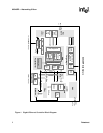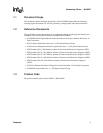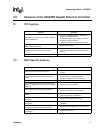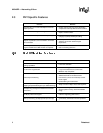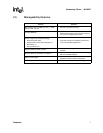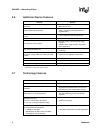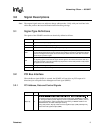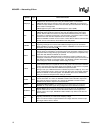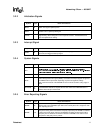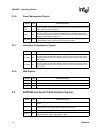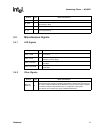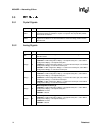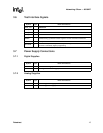
82540EP — Networking Silicon
8 Datasheet
2.6 Additional Device Features
2.7 Technology Features
Features Benefits
Four activity and link indication outputs that directly
drive LEDs
• Link and activity indications (10, 100, and 1000
Mbps) on each port
Programmable LED functionality
• Software definable function (speed, link, and
activity) and blinking allowing flexible LED
implementations
Internal PLL for clock generation can use a 25 MHz
crystal
• Lower component count and system cost
JTAG (IEEE 1149.1) Test Access Port built in silicon • Simplified testing using boundary scan
On-chip power control circuitry
a
a. If applying the “low-power” EEPROM setting for the 82540EP chip, then only external voltage regulator circuits should be used
instead of the on-chip power control circuitry
• Reduced number of on-board power supply
regulators
• Simplified power supply design in less power-
critical applications
Four software definable pins
• Additional flexibility for LEDs or other low speed
I/O devices
Supports little endian byte ordering for both 32 and 64
bit systems and big endian byte ordering for 64 bit
systems
• Portable across application architectures
Two or three-pair cable downshift • Supports modular hardware accessories
Provides loopback capabilities • Validates silicon integrity
Minimal ballout change from the 82540EM • Pin Compatibility
Features Benefits
196-pin Ball Grid Array (TFBGA) package • 15 mm
2
component making LOM designs easier
Pin compatible with 82551QM and 82540EM
controllers
• Enables 10/100 Mbps Fast Ethernet or 1000 Mbps
Gigabit Ethernet implementations on the same
board with only minor stuffing option changes
Implemented in 0.15u CMOS process
• Offers lowest geometry to minimize power and
size while maintaining Intel quality reliability
standards
Operating temperature: 0
° C to 70° C (maximum)
operating temperature
Heat sink or forced airflow not required
65
° C to 140° C storage temperature range
• Simple thermal design
PCI Signaling: 3.3 V (5 V tolerant) PCI signaling
Typical targeted power dissipation:
• 1.38W @ D0 1000 Mb/s
• 386mW @ D3 100 Mb/s (wake-up enabled)
• <20mW @ D3 wake-up disabled
• Lower power requirements for mobile applications





